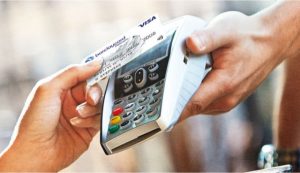Giant card issuer Chase once again will issue contactless credit and debit cards, the bank announced Wednesday.
Chase, a unit of JPMorgan Chase & Co., says it will begin later this year issuing contactless EMV cards bearing the Visa Inc. brand, first to its Chase Freedom Unlimited and Chase Slate cardholders as their cards reach renewal or on opening a new account. Following on will be all other Chase Visa credit cards, including co-branded ones through 2019. In the second half of 2019, Chase contactless debit cards will begin appearing.

Chase said the timing is right because 70% of U.S. merchants have the point-of-sale technology to accept contactless EMV cards. It’s the same technology used by mobile wallets like Apple Pay, Samsung Pay, and Google Pay.
Thirteen years ago Chase, with its blink card, was one of the first to issue a contactless payment card on a broad scale. Those cards relied on magnetic-stripe-equivalent radio frequency technology. Other issuers followed, but contactless payments failed to catch on. The blink brand lingered until its last incarnation was discontinued in 2014. These newest cards use EMV contactless technology to secure the payment data.
Different this time, too, is that one leg of the stool already is in place. Since the 2015 EMV liability shift, point-of-sale terminal makers have shipped their devices not only enabled for contact EMV acceptance, but with near-field communication wireless capability built in. NFC is the enabling technology for the smart phone-based mobile wallets and for contactless EMV cards.
In September, Visa said 50% of its face-to-face transactions happened at contactless-enabled merchant locations as of June, meaning the merchant’s point-of-sale equipment was enabled for, not just capable of, conducting a contactless card payment.
In October, Visa predicted 100 million contactless cards would be issued by U.S. banks and credit unions by the end of 2019. It’s an attainable number because of the readiness of the market, suggests Dan Sanford, vice president of product at Visa.
The technology is in place at merchants, and now, with at least one issuer moving ahead and others expected to follow, the payments industry soon can focus on consumers. Part of that consumer message will be the value of using contactless cards, which will retain the contact chip interface, instead of cash, Sanford says.
As other markets, such as Australia and the United Kingdom, added contactless capability to their EMV cards, consumers began using the cards instead of cash, he says. That could happen in the United States.
That’s where consumers will have a critical role, not only for using a card instead of cash but to prompt merchants to offer contactless acceptance, says Kevin Morrison, senior analyst at Aite Group LLC, a Boston-based advisory firm. “It will largely be driven by the spending habits of the average consumer,” Morrison tells Digital Transactions News. A consumer who gets accustomed to tap-and-pay at a fast-food restaurant may wonder why a similar experience, which likely will take less time than dipping an EMV card into a reader, can’t happen at other merchants, he says.
“Now that 50% of card transaction volume is occurring at contactless enabled terminals, there is sound evidence that consumers will see contactless as a natural progression from using contact-only chip cards and will tap if they have the chance,” says Randy Vanderhoof, director of the U.S. Payments Forum.
Card costs also may be a factor. On the low end the cost may be 50 cents to 60 cents per card and on the high end between 90 cents and $1.10. Morrison says volume and other elements affect card costs. Even global demand for contactless cards helps lower costs, he says. A contact-only EMV card may cost between 60 cents and 80 cents. Chase would not disclose its costs for the new cards.
Another factor that bodes well is that other issuers are expected to follow Chase’s lead. Morrison’s research indicates that large and small financial institutions are planning contactless cards, a trend that picked up momentum in the last five months, he says. “When the big guys move, the little guys don’t want to be left [behind],” he says. “There are a number of financial institutions that are going to migrate to this technology,” Morrison says. “It will take off.”
There’s no discounting the impact of Chase, says Brian Riley, director of the credit advisory service at Maynard, Mass.-based Mercator Advisory Group. “Chase’s issuing side generates more than 22% of U.S. credit card sales and their merchant acquiring business has a 19% market share,” Riley says in an email to Digital Transactions News. “You can be certain that Chase can drive contactless EMV cards in the market, that they can certainly influence consumers and merchants.”





